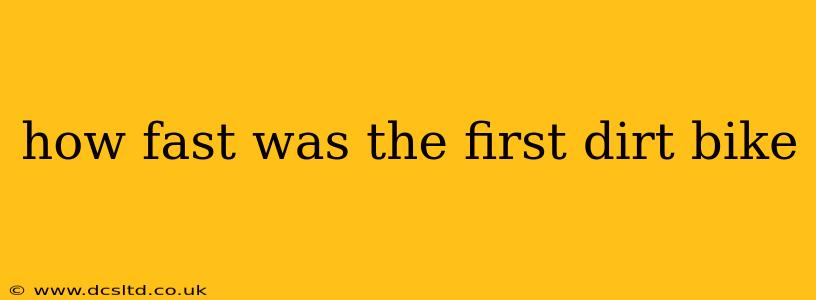The question "How fast was the first dirt bike?" isn't easily answered with a single speed. The definition of a "dirt bike" itself evolved, and early machines varied significantly in design and performance. However, we can explore the evolution of these early motorcycles and provide a better understanding of their capabilities.
What Defines a "Dirt Bike"?
Before diving into speeds, let's clarify what constitutes a "dirt bike." The term wasn't initially used; early off-road motorcycles were often modified street bikes or purpose-built machines designed for various off-road tasks, not just racing. The key differentiators emerging over time included:
- Lightweight Frame: Dirt bikes prioritize maneuverability, demanding lighter frames than their street counterparts.
- High Ground Clearance: Essential for navigating rough terrain.
- Long-Travel Suspension: Absorbs shocks and bumps encountered off-road.
- Knobby Tires: Provide grip on loose surfaces like dirt, sand, and mud.
Early Off-Road Motorcycles: Speed and Capabilities
The earliest motorcycles adapted for off-road use weren't built for speed in the same way modern dirt bikes are. Their top speeds were significantly lower, often in the range of 25-40 mph. This is because:
- Engine Technology: Early motorcycle engines were less powerful and less refined than later models.
- Transmission Limitations: Gear ratios were often geared toward low-speed torque rather than high-speed performance.
- Tire Design: Early knobby tires offered superior traction but generated more rolling resistance, impacting top speed.
Think of machines like the early Excelsior motorcycles, or modified Indian motorcycles of the early 20th century. These weren't purpose-built dirt bikes as we know them, but rather, adapted machines used for traversing varied terrains. Their top speed was a secondary consideration to reliability and durability on rough tracks.
What were the top speeds of early motocross bikes?
As motocross gained popularity in the post-World War II era, dedicated off-road motorcycles began to emerge. These bikes were still relatively low-powered compared to today's standards, but their speeds increased gradually. Top speeds in the early days of motocross (1950s-1960s) might reach 50-60 mph on certain stretches of track, but average speeds during races were considerably lower due to the challenging terrain.
How did dirt bike technology affect speed?
Advancements in engine technology, suspension systems, and tire design dramatically increased the speed and performance of dirt bikes over time. The introduction of lighter materials, improved aerodynamics, and more powerful engines all contributed to significant speed increases.
What are the speeds of modern dirt bikes?
Modern dirt bikes, depending on the class and engine size, can achieve top speeds exceeding 80 mph on flat, smooth surfaces. However, their optimal performance remains in the lower to mid-speed ranges, prioritizing handling and control on varied terrains.
Conclusion: It's More Than Just Speed
While pinpointing the exact top speed of the "first" dirt bike is impossible, it's clear that early off-road machines were significantly slower than their modern counterparts. The emphasis shifted from raw speed to capabilities essential for navigating challenging environments. The evolution of dirt bikes is a fascinating story of technological innovation, driven by the ever-increasing demands of riders pushing the boundaries of off-road riding.
